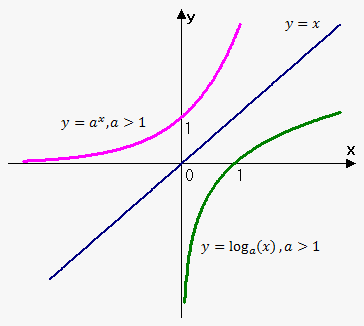Logarithmic Functions
 Since exponential function $$${y}={{a}}^{{x}}$$$ is monotonic (i.e. either increasing or decreasing) then it passes horizontal line test. Thus, it has inverse function. To find this function we use algorithm for finding inverse.
Since exponential function $$${y}={{a}}^{{x}}$$$ is monotonic (i.e. either increasing or decreasing) then it passes horizontal line test. Thus, it has inverse function. To find this function we use algorithm for finding inverse.
Interchange $$${x}$$$ and $$${y}$$$: $$${x}={{a}}^{{y}}$$$. To write this in terms of $$${y}$$$ we introduce new record: $$${y}={\log}_{{a}}{\left({x}\right)}$$$.
So, $$${x}={{a}}^{{y}}$$$ is equivalent to $$${y}={\log}_{{a}}{\left({x}\right)}$$$. For example, $$${\log}_{{2}}{\left({8}\right)}={3}$$$ because $$${{2}}^{{3}}={8}$$$.
Function $$${y}={\log}_{{a}}{\left({x}\right)}$$$ is called logarithmic function. Its domain is $$${\left({0},\infty\right)}$$$ and range is $$${\left(-\infty,\infty\right)}$$$.
Since $$${y}={\log}_{{a}}{\left({x}\right)}$$$ is inverse of $$${y}={{a}}^{{x}}$$$ then their graphs are symmetric about line $$${y}={x}$$$.
Properties of Logarithms
If $$${x}$$$ and $$${y}$$$ are positive numbers then
- $$${{a}}^{{{\log}_{{a}}{\left({x}\right)}}}={x}$$$, for any $$${x}$$$,
- $$${\log}_{{a}}{\left({{a}}^{{x}}\right)}={x}$$$, for $$${x}>{0}$$$,
- $$${\log}_{{a}}{\left({x}{y}\right)}={\log}_{{a}}{\left({x}\right)}+{\log}_{{a}}{\left({y}\right)}$$$,
- $$${\log}_{{a}}{\left(\frac{{x}}{{y}}\right)}={\log}_{{a}}{\left({x}\right)}-{\log}_{{a}}{\left({y}\right)}$$$,
- $$${\log}_{{a}}{\left({{x}}^{{b}}\right)}={b}{\log}_{{a}}{\left({x}\right)}$$$ (where $$${b}$$$ is any real number)
First two properties follow from definition of inverse, last three properties follow from corresponding properties of exponentials.
Example 1. Evaluate $$${\log}_{{2}}{\left({3}\right)}+{\log}_{{2}}{\left({20}\right)}-{\log}_{{2}}{\left({15}\right)}$$$.
Using properties of logarithms we can write that $$${\log}_{{2}}{\left({3}\right)}+{\log}_{{2}}{\left({20}\right)}-{\log}_{{2}}{\left({15}\right)}={\log}_{{2}}{\left({3}\cdot{20}\right)}-{\log}_{{2}}{\left({15}\right)}={\log}_{{2}}{\left({60}\right)}-{\log}_{{2}}{\left({15}\right)}={\log}_{{2}}{\left(\frac{{60}}{{15}}\right)}={\log}_{{2}}{\left({4}\right)}={2}$$$
because $$${{2}}^{{2}}={4}$$$.
Natural logarithm
Of all possible bases $$${a}$$$ the most convenient when working with logarithms is base $$${e}$$$ (number $$${e}\approx{2.718}$$$). We will talk why is this so in next notes.
So, logarithm with base $$${e}$$$ is called natural logarithm and is denoted as $$${\ln{{\left({x}\right)}}}$$$: $$${\log}_{{e}}{\left({x}\right)}={\ln{{\left({x}\right)}}}$$$.
From definition of inverse it follows that $$${\ln{{\left({x}\right)}}}={y}\ \Leftrightarrow\ {{e}}^{{y}}={x}$$$.
Also, $$${\ln{{\left({{e}}^{{x}}\right)}}}={x}$$$ for $$${x}\in{\left(-\infty,\ \infty\right)}$$$ and $$${{e}}^{{{\ln{{\left({x}\right)}}}}}={x}$$$ for $$${x}>{0}$$$.
In particular $$${\ln{{\left({e}\right)}}}={1}$$$.
Example 2. Solve equation $$${{e}}^{{{3}{x}+{5}}}={4}$$$.
Take natural logaritms of both sides: $$${\ln{{\left({{e}}^{{{3}{x}+{5}}}\right)}}}={\ln{{\left({4}\right)}}}$$$ or $$${3}{x}+{5}={\ln{{\left({4}\right)}}}$$$, so $$${x}=\frac{{{\ln{{\left({4}\right)}}}-{5}}}{{3}}$$$.
Example 3. Solve $$${\ln{{\left({{x}}^{{3}}+{1}\right)}}}={2}$$$.
Apply exponential function to both sides of equation: $$${{e}}^{{{\ln{{\left({{x}}^{{3}}+{1}\right)}}}}}={{e}}^{{2}}$$$ or $$${{x}}^{{3}}+{1}={{e}}^{{2}}$$$.
So, $$${x}={\sqrt[{{3}}]{{{{e}}^{{2}}-{1}}}}$$$.
Example 4. Simplify $$${2}{\ln{{\left({x}\right)}}}-\frac{{1}}{{3}}{\ln{{\left({y}\right)}}}$$$.
Using properties of logarithms we can write that $$${2}{\ln{{\left({x}\right)}}}-\frac{{1}}{{3}}{\ln{{\left({y}\right)}}}={\ln{{\left({{x}}^{{2}}\right)}}}-{\ln{{\left({{y}}^{{\frac{{1}}{{3}}}}\right)}}}={\ln{{\left(\frac{{{{x}}^{{2}}}}{{{{y}}^{{\frac{{1}}{{3}}}}}}\right)}}}$$$.
Now, let's see how can we express logaritm with one base through logarithm with another base.
Let $$${y}={\log}_{{a}}{\left({x}\right)}$$$. This means that $$${{a}}^{{y}}={x}$$$.
Taking logarithms with base $$${b}$$$ we have that $$${\log}_{{b}}{\left({{a}}^{{y}}\right)}={\log}_{{b}}{\left({x}\right)}$$$ or $$${y}{\log}_{{b}}{\left({a}\right)}={\log}_{{b}}{\left({x}\right)}$$$.
Thus, $$${y}=\frac{{{\log}_{{b}}{\left({x}\right)}}}{{{\log}_{{b}}{\left({a}\right)}}}$$$. From another side $$${y}={\log}_{{a}}{\left({x}\right)}$$$.
Finally, $$${\log}_{{a}}{\left({x}\right)}=\frac{{1}}{{{\log}_{{b}}{\left({a}\right)}}}{\log}_{{b}}{\left({x}\right)}$$$.
Change of base formula. $$${\log}_{{a}}{\left({x}\right)}=\frac{{{\log}_{{b}}{\left({x}\right)}}}{{{\log}_{{b}}{\left({a}\right)}}}$$$.
In case when $$${b}={e}$$$ we can write equation as $$${\color{blue}{{{\log}_{{a}}{\left({x}\right)}=\frac{{\ln{{\left({x}\right)}}}}{{\ln{{\left({a}\right)}}}}}}}$$$.
